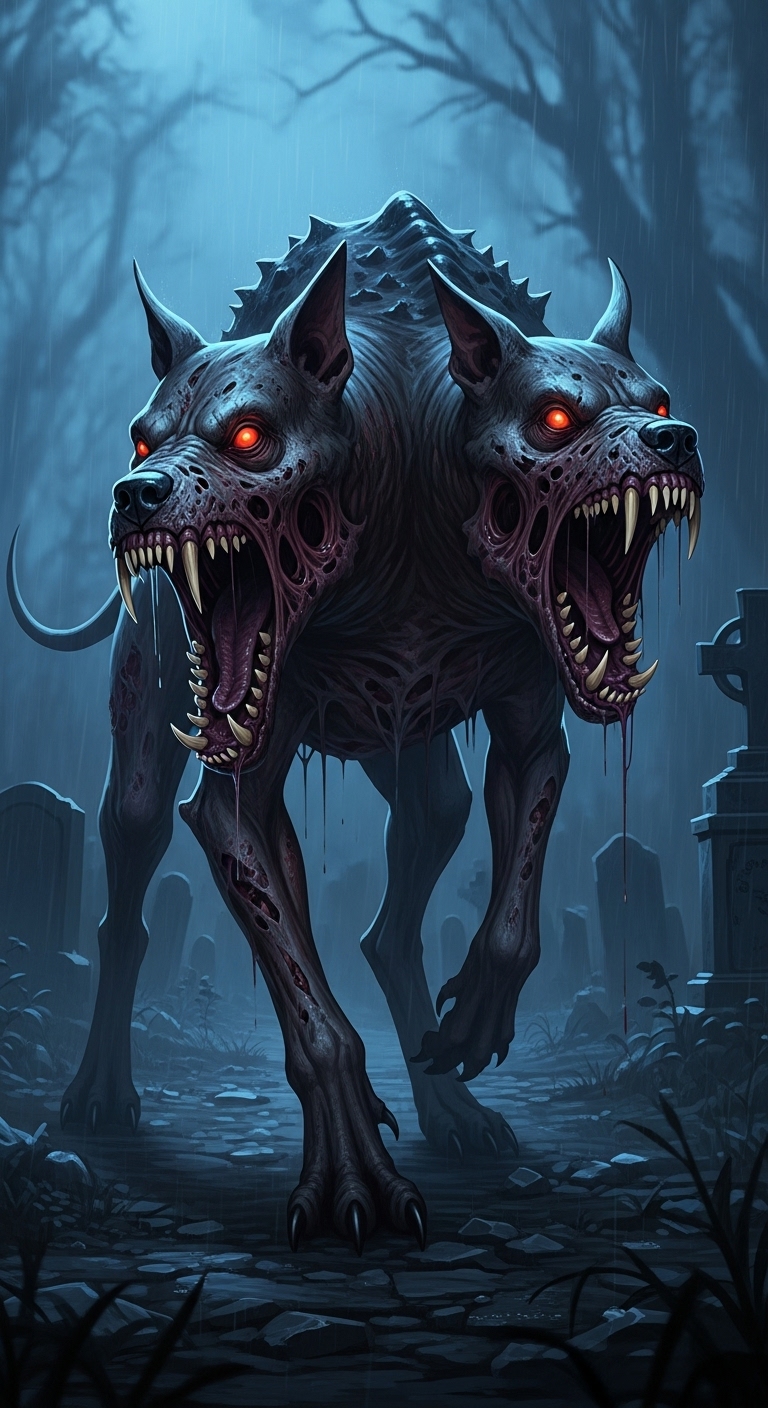Death Dog

- Size: Medium
- Type: Monstrosity
- Alignment: Neutral Evil
- AC: 12
- Initiative: +2 (12)
- HP: 39 (6d8 + 12)
- Speed: 40 ft
| ATTR | VAL | MOD | SAVE |
|---|---|---|---|
| STR | 15 | +2 | +2 |
| Dex | 14 | +2 | +2 |
| Con | 14 | +2 | +2 |
| INT | 3 | -4 | -4 |
| Wis | 13 | +1 | +1 |
| CHA | 6 | -2 | -2 |
- Skills: Perception +5 , Stealth +4
- Immunities: Blinded, Charmed, Deafened, Frightened, Stunned, Unconscious
- Senses: Darkvision 120 ft.; Passive Perception 15
- Languages: None
- CR: 1 (XP 200; PB +2 )
Actions
Multiattack. The death dog makes two Bite attacks.
Bite. Melee Attack Roll: +4 , reach 5 ft . Hit: 4 (1d4 + 2) Piercing damage. If the target is a creature, it is subjected to the following effect. Constitution Saving Throw: DC 12. First Failure: The target has the Poisoned condition. While Poisoned, the target's Hit Point maximum doesn't return to normal when finishing a Long Rest, and it repeats the save every 24 hours that elapse, ending the effect on itself on a success. Subsequent Failures: The Poisoned target's Hit Point maximum decreases by 5 (1d10).
Lore & Background
Death dogs are two-headed undead canines that serve as harbingers of disease and decay. These grotesque creatures were once ordinary dogs that died from plague or were killed in areas tainted by necromantic magic, only to rise again as carriers of supernatural disease. Their dual heads represent the duality of life and death, with each head capable of independent thought and action while sharing a single undead body.
These creatures are naturally drawn to areas of death and decay, often appearing in plague-stricken cities, battlefields, or regions affected by necromantic magic. Death dogs serve as both symptoms and spreaders of supernatural disease, creating cycles of infection that can devastate entire communities. They retain some memories and instincts from their living days but are driven primarily by an insatiable hunger for living flesh.
Death dogs often travel in packs, their disease spreading exponentially as they move through populated areas. They are particularly attracted to the sick and dying, as if drawn by the scent of impending death. Some necromancers deliberately create death dogs to serve as shock troops or to spread plague among enemy populations, making them weapons of biological warfare.
Combat Tactics
Death dogs rely on their disease-carrying bite attacks to weaken enemies over time while using pack tactics to overwhelm individual opponents. Each head can attack independently, allowing them to engage multiple enemies simultaneously or focus their attacks on a single dangerous foe. Their primary goal is to spread their supernatural disease rather than achieve quick kills.
These creatures use hit-and-run tactics, biting enemies and then retreating to allow the disease to take effect before engaging again. They are intelligent enough to target spellcasters and healers first, recognizing that these individuals pose the greatest threat to their disease-spreading mission. Death dogs coordinate well with other undead, often serving as advance scouts for larger undead forces.
When facing groups of enemies, death dogs attempt to separate and isolate individuals, using their pack instincts to surround and overwhelm isolated targets. They are particularly dangerous in confined spaces where their disease can spread more easily and where retreat is difficult for their victims.
Encounter Ideas
The Plague Carriers: Death dogs have appeared in a city during a plague outbreak, making it unclear whether they're the cause of the disease or simply attracted to it.
The Necromancer's Hounds: A necromancer uses death dogs as both guardians and weapons, sending them to spread disease among enemy populations before launching larger attacks.
The Infected Pack: A pack of death dogs roams the countryside, leaving a trail of disease and death as they move from settlement to settlement.
The Hospital Horror: Death dogs have infiltrated a healing temple or hospital, targeting the sick and wounded while spreading their supernatural plague to healers and patients alike.
Environmental Effects
Disease Zones: Areas where death dogs have been active become contaminated with supernatural disease, creating ongoing health hazards for anyone who enters.
Decay Acceleration: The presence of death dogs causes organic matter to rot and decay more quickly, affecting food supplies and natural vegetation.
Scavenger Attraction: The death and decay associated with death dogs attracts other scavengers and carrion feeders, creating complex ecological disruptions.
Quarantine Necessity: Communities affected by death dogs often implement strict quarantine measures, disrupting trade and social interactions.
Treasure
Plague Remedies: Areas affected by death dogs often contain valuable medicines, herbs, and magical items designed to combat disease and restore health.
Necromantic Components: The death dogs themselves provide materials useful for creating undead or for necromantic rituals, though handling them requires extreme caution.
Abandoned Wealth: Victims of death dog attacks often leave behind valuable possessions that can be recovered once the disease threat is neutralized.
Medical Knowledge: Surviving the death dog plague often leads to advances in medical knowledge and the development of new treatments and cures.
Plot Hooks
The Immune Survivor: Someone has survived death dog disease and developed immunity, making them valuable for creating cures but also a target for those who would exploit their condition.
The Source Investigation: Death dogs are appearing in increasing numbers, and tracking their origin requires investigating plague sites, necromantic experiments, or supernatural corruption.
The Cure Quest: A death dog outbreak threatens a major population center, and finding a cure requires gathering rare ingredients or seeking help from powerful healers.
The Undead Pack Leader: An intelligent undead creature is commanding death dogs as part of a larger plan, using them to weaken defenses before launching a major assault.